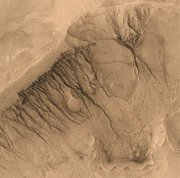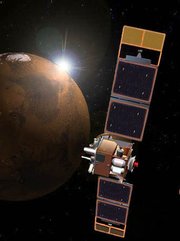Mars Global Surveyor
|
|
The launch of the Mars Global Surveyor (MGS) spacecraft in November 1996 by NASA and the Jet Propulsion Laboratory began America's return to Mars after a 20-year absence.
The Surveyor spacecraft, fabricated at the Lockheed Martin Astronautics plant in Denver, is a rectangular-shaped box with wing-like projections extending from opposite sides. When fully loaded with propellant at the time of launch, the spacecraft weighed only 1,060-kilograms (2,342 pounds). Most of Surveyor's mass lies in the box-shaped module occupying the center portion of the spacecraft. In reality, this center module is made of two smaller rectangular modules stacked on top of each other. One of the two smaller modules, called the equipment module, holds all of the spacecraft's electronics and science instruments. The other, called the propulsion module, houses Surveyor's rocket engines and propellant tanks.
| Contents |
Mission chronology
The Surveyor spacecraft was launched from the Cape Canaveral Air Station in Florida on November 7, 1996 aboard a Delta-7925 rocket. The spacecraft travelled nearly 750 million kilometers (466 million miles) over the course of a 300-day cruise to reach Mars on September 11 1997.
Upon reaching Mars, Surveyor fired its main rocket engine for the 22-minute Mars orbit insertion (MOI) burn. This maneuver slowed the spacecraft and allowed the planet's gravity to capture it into orbit. Initially, Surveyor entered a highly elliptical orbit that took 45 hours to complete. The orbit had a periapsis of 262 km above the northern hemisphere, and an apoapsis of 54,026 km above the southern hemisphere.
After orbit insertion, Surveyor performed a series of orbit changes to lower the periapsis of its orbit into the upper fringes of the Martian atmosphere at an altitude of about 110 kilometers (68 miles). During every atmospheric pass, the spacecraft slowed down by a slight amount because of air resistance. This slowing caused the spacecraft to lose altitude on its next pass through the orbit's apoapsis. Surveyor used this aerobraking technique over a period of four months to lower the high point of its orbit from 54,000 kilometers to altitudes near 450 kilometers.
On October 11 the flight team performed a maneuver to raise the periapsis out of the atmosphere. This suspension of aerobraking was performed because air pressure from the atmosphere caused one of Surveyor's two solar panels to bend backward by a slight amount. The panel in question was slightly damaged shortly after launch in November 1996. Aerobraking was resumed on November 7 after flight team members concluded that aerobraking was safe, provided that it occurs at a more gentle pace than proposed by the original mission plan.

Under the new mission plan, aerobraking occurred with the low point of the orbit at an average altitude of 120 km, as opposed to the original altitude of 110 km. This slightly higher altitude resulted in a decrease of 66% in terms of air resistance pressure experienced by the spacecraft. During these six months, aerobraking reduced the orbit period down to between 12 to 6 hours.
From May to November 1998, aerobraking was temporarily suspended to allow the orbit to drift into the proper position with respect to the Sun. Without this hiatus, Surveyor would complete aerobraking with its orbit in the wrong solar orientation. In order to maximize the efficiency of the mission, these six months were devoted to collecting as much science data as possible. Data was be collected between two to four times per day, at the low point of each orbit.
Finally, from November 1998 to March 1999, aerobraking continued and shrank the high point of the orbit down to 450 km. At this altitude, Surveyor circled Mars once every two hours. Aerobraking was scheduled to terminate at the same time the orbit drifted into its proper position with respect to the Sun. In the desired orientation for mapping operations, the spacecraft always crossed the day-side equator at 14:00 (local Mars time) moving from south to north. This geometry was selected to enhance the total quality of the science return.
During mapping operations, the spacecraft circles Mars once every 117.65 minutes at an average altitude of 378 kilometers (235 miles). It is in a polar orbit which is nearly perfectly circular, moving from being over the south pole to being over the north pole in just under an hour. The altitude is chosen to make the orbit sun-synchronous, so that all images taken by the spacecraft of the same surface features on different dates are taken under identical lighting conditions.
After each orbit, the spacecraft has moved 28.62° to the west because Mars has rotated underneath it. In effect, it is always 14:00. for Mars Global Surveyor as it moves from one time zone to the next exactly as fast as the Sun.
After 7 sols and 88 orbits, the spacecraft approximately retraces its previous path, but offset by 59 km eastward. This ensures eventual full coverage of the entire surface.
On March 30, 2004 Surveyor photographed the Mars Exploration Rover Spirit along with its wheel tracks showing its first 85 sols of travel.
In April of 2005, MGS became the first spacecraft to photograph another spacecraft in orbit around a planet other than Earth when it captured two images of the Mars Odyssey spacecraft and one image of the Mars Express spacecraft.
| Missing image Mgs_mer.gif The Mars Rover Spirit's landing site and tracks taken by Mars Global Surveyor. | Missing image Mgs_express.gif The Mars Express spacecraft image taken by Mars Global Surveyor. | Missing image Mgs_odyssey.gif The Mars Odyssey spacecraft image taken by Mars Global Surveyor. |
MER Communications Subsystem
The spacecraft also functions as a communications satellite to relay data back to Earth from the MER surface landers.
References
Related articles
External links
- NASA JPL Mars Link (http://mars.jpl.nasa.gov/mgs/)
- NASA mission overview (http://marsprogram.jpl.nasa.gov/missions/present/globalsurveyor.html)
- Global Surveyor Mission plan (http://www.msss.com/mars/global_surveyor/mgs_msn_plan/)
- Malin Space Science Systems (http://www.msss.com/) (complete image gallery)de:Mars Global Surveyor
es:Mars Global Surveyor fa:نقشهبردار سراسر مریخ fr:Mars Global Surveyor hu:Mars Global Surveyor

